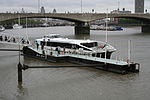Cleopatra's Needle, London

Cleopatra's Needle in London (similarly named obelisks exist in New York and Paris) is an ancient Egyptian obelisk located on the Victoria Embankment in Westminster, London. Inscribed by Thutmose III and later Ramesses II of the Egyptian New Kingdom, the obelisk was moved to Alexandria in 12 BC, where it remained for nearly two millennia before it was presented to the United Kingdom in 1819 by the ruler of Egypt and Sudan Muhammad Ali, in commemoration of the victories of Lord Nelson at the Battle of the Nile and Sir Ralph Abercromby at the Battle of Alexandria in 1801. Although the British government welcomed the gesture, it declined to fund the expense of transporting it to London.
Excerpt from the Wikipedia article Cleopatra's Needle, London (License: CC BY-SA 3.0, Authors, Images).Cleopatra's Needle, London
Victoria Embankment, City of Westminster Covent Garden
Geographical coordinates (GPS) Address External links Nearby Places Show on map
Geographical coordinates (GPS)
| Latitude | Longitude |
|---|---|
| N 51.508517 ° | E -0.120336 ° |
Address
Cleopatra's Needle
Victoria Embankment
WC2R 2AB City of Westminster, Covent Garden
England, United Kingdom
Open on Google Maps










